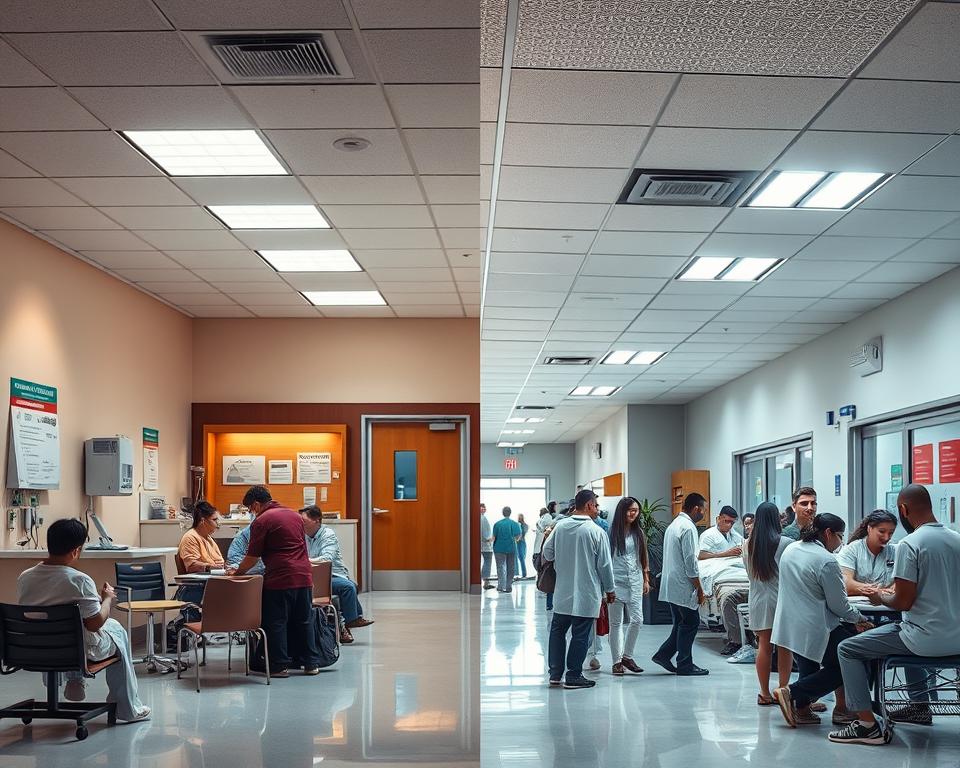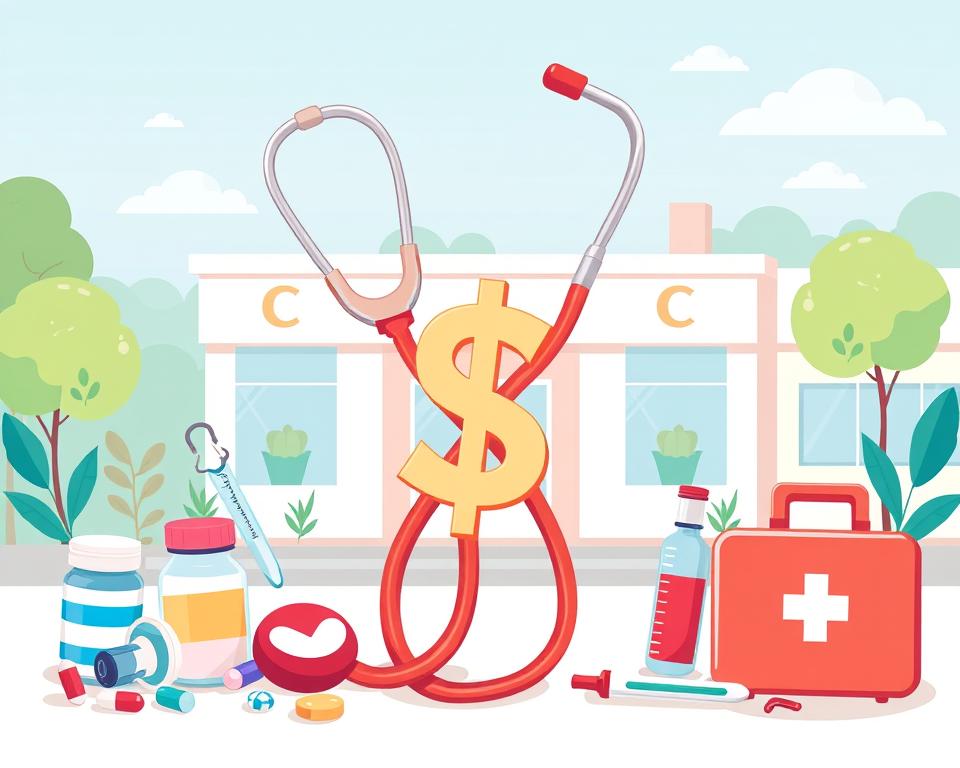Hospitals can save about 11% by outsourcing food service. This shows how big of an impact healthcare costs have on families. In this guide, you’ll find many ways to cut down on what you pay for medical care. You’ll still get the care you and your family need.
Understanding Modern Healthcare Expenses
The healthcare scene in the United States has seen big changes lately. This has led to higher healthcare costs. These costs are now a big problem for many American families, making tough choices about their health care.
Current Healthcare Cost Trends
Inflation has gone up by 12.4% from 2021 to 2023. This is more than double the rate of Medicare’s increase for hospital care. This fast rise in costs is hard on healthcare providers. Hospitals and health systems now have 28.3% less cash on hand since 2022.
Common Factors Driving Up Medical Expenses
Several things are making healthcare costs go up. These include new medical technologies, higher prices for prescription drugs, and more administrative costs. Hospitals also get underpaid by Medicare and Medicaid, losing nearly $130 billion in 2022. Medicare only pays 82 cents for every dollar hospitals spend on patient care.
Impact on American Households
Higher healthcare costs are affecting many American families. In 2022, hospitals saw nearly 137 million emergency department patients and over 3.5 million babies were born. The cost of these services can be very hard for families to handle, leading to tough choices and financial stress.
“The financial burden of these expenses can be overwhelming, leading to difficult decisions and potential financial strain for many families.”

How to Save on Healthcare Costs
Dealing with healthcare can be tough, but there are ways to cut costs. You can find affordable health services and insurance plans. By making smart choices and using available resources, you can lower your healthcare expenses.
Utilizing your insurance to its maximum potential is a wise decision. Choose doctors and hospitals in your network, as they often charge less. Also, use free preventive care to stay healthy and avoid expensive treatments later.
For medicines, go for generics. They work just like brand names but cost less. Your health plan might also offer discounts on things like gym memberships and glasses. So, check those out too.
- Utilize in-network healthcare providers to take advantage of lower negotiated rates
- Take advantage of preventive care services covered by your health plan
- Choose generic medications over brand-name drugs whenever feasible
- Look for discounts on gym memberships, eyewear, and other health-related services offered by your plan
For urgent care, plan ahead to avoid high costs. Use outpatient centers for some procedures, as they’re cheaper than hospitals. Also, staying healthy through exercise and good eating can prevent expensive medical bills.
“Staying proactive about your health and making informed choices can go a long way in reducing your healthcare expenses.”
By using these cost-saving tips, you can manage your healthcare spending. This way, you and your family can get the health services you need without spending too much.

Maximizing Health Insurance Benefits
Understanding health insurance can be tough, but knowing your options is crucial. It helps you save on healthcare costs. You can use strategies like choosing in-network providers and taking advantage of preventive care to get the most from your plan.
Understanding Your Coverage Options
It’s important to know the details of your health insurance plan. This includes your out-of-pocket maximum, copays, and deductible. These can affect how much you pay for healthcare. Also, check your prescription coverage and network coverage to make sure your doctors and meds are covered.
In-Network vs. Out-of-Network Providers
Choosing in-network providers can save you money. They have deals with your insurance, which means lower costs for you. On the other hand, out-of-network providers might cost more, with higher deductibles and copays.
Preventive Care Services
- Many plans offer free preventive care services like check-ups and screenings. Using these can keep you healthy and catch problems early, saving you money.
- Also, check if your plan covers medical supplies. This can help with the cost of medical equipment and supplies.
By understanding your health insurance and making smart choices, you can get the most from your coverage. This way, you can access affordable medical care that fits your needs and budget. If you have questions, don’t hesitate to contact your insurance provider’s support team.
Smart Prescription Drug Savings Strategies
Prescription drug costs can be a big part of healthcare expenses. Luckily, there are ways to save money on your meds. By using these smart strategies, you can cut down on healthcare costs and find affordable health services.
Switching to generic drugs is a smart move. Generic meds have the same ingredients as brand-name ones but cost less. The Centers for Medicare & Medicaid Services (CMS) says switching can save you hundreds or thousands of dollars a year.
Another way to save is to ask your doctor about cheaper options. Many health plans have different tiers of medications. Tier 1 includes generics with lower copays. Talking to your doctor can help you find affordable alternatives that meet your needs.
Using mail-order pharmacies can also cut down your costs. Getting a 3-month supply of maintenance meds delivered can lower your copays, as the CMS notes.
It’s key to take your meds as directed. Skipping them can lead to worse health, more hospital visits, and higher costs, the CDC warns.
Some health plans offer rebates or discounts on meds. It’s vital to check your plan’s coverage and use any savings you can find.
“Skipping needed drugs can lead to worsening health conditions, more trips to the hospital, and ultimately, higher healthcare costs.”
By using these smart strategies, you can lower your healthcare costs and find affordable health services. Always work with your healthcare providers to explore all options and make the best choices for your medication.

Leveraging Health Savings Accounts (HSA) and Flexible Spending Accounts (FSA)
Health Savings Accounts (HSAs) and Flexible Spending Accounts (FSAs) help save money on healthcare costs. They let you put aside money before taxes for medical bills. This can save you hundreds of dollars each year.
Tax Benefits and Advantages
Money put into an HSA isn’t taxed and it grows tax-free. This makes HSAs great for saving on healthcare costs and planning for the future. FSAs also let you pay for healthcare costs without paying taxes on them.
Qualifying Expenses
HSAs and FSAs cover many medical costs. This includes doctor visits, hospital bills, and some dental and vision care. Knowing what expenses are covered is key to getting the most from these accounts.
Annual Contribution Limits
In 2021, you can contribute up to $3,600 to an HSA for yourself or $7,200 for your family. If you’re 55 or older, you can add $1,000 more. FSAs have different limits, set by your employer.
Using HSAs and FSAs wisely can greatly lower your healthcare cost optimization and medical bills. They’re a smart way to plan for both now and later, saving on taxes.

“The average U.S. couple will need over $300,000 to cover out-of-pocket health-care costs in retirement.”
Choosing Between Urgent Care and Emergency Services
Choosing between urgent care and emergency services can be tough. But knowing the differences can save you money. It helps you find cost-effective healthcare options and affordable medical care.
Emergency care is for serious issues like severe injuries or chest pains. Urgent care deals with less urgent but still important health problems. These include minor injuries or illnesses.
Urgent care is cheaper and has shorter wait times than emergency rooms. Emergency room visits can cost up to 10 times more. Only 12.4% of these visits led to hospital stays in 2018.
Knowing where urgent care centers are and what’s a real emergency helps. There are now 9,616 urgent care centers in the U.S. They offer a cheaper and more accessible option.
“Urgent care centers reduce costly ED visits by about 17% in areas with the presence of an urgent care center in a zip code.”
Choosing the right place for care saves time and money. It also improves your health. Knowing the difference between urgent care and emergency services is key. It helps you get cost-effective healthcare options and affordable medical care.

Negotiating Medical Bills and Payment Plans
Dealing with medical billing can be tough, but knowing how it works can help a lot. Patients who check their bills and talk to providers can save a lot of money. This can cut down healthcare costs by thousands each year.
Understanding Medical Billing
Medical billing often has mistakes, and it’s key to check your bills carefully. Studies show that up to 80% of medical bills have errors. By looking closely at your bill and asking for a detailed statement, you can spot overcharges or fees you don’t need.
Tips for Successful Negotiation
- Be prepared: Gather all relevant documentation, including your insurance Explanation of Benefits (EOB), any records of billing errors, and information on average procedure costs.
- Negotiate politely: Approach the conversation with healthcare providers or insurers in a friendly and professional manner. Avoid confrontation, but firmly advocate for fair pricing.
- Explore financial assistance: Many hospitals and healthcare organizations offer financial assistance programs for low-income or uninsured patients. Don’t be afraid to inquire about these options.
- Consider alternative payment plans: If you’re unable to negotiate a lower overall bill, ask about setting up a manageable payment plan with the provider.
- Leverage technology: Innovative solutions like AI-driven tools can automate the process of negotiating with insurers, helping you optimize your healthcare cost management.
By understanding medical billing and using good negotiation tactics, patients can play a big role in managing medical bills and healthcare cost optimization. This can lead to big savings and make healthcare more affordable for families in the U.S.

“Negotiating medical bills can lower annual healthcare costs by thousands of dollars.”
Preventive Healthcare Measures for Long-term Savings
Adding preventive healthcare to your life can save you a lot of money over time. Many health plans cover these services without extra costs. This makes it a great way to stay healthy while saving money.
Regular check-ups, screenings, and vaccines are key to preventive care. They help find problems early, so you can get treatment quickly. Eating right, exercising, and avoiding bad habits like smoking also cut down healthcare costs.
- Nearly 40% of all deaths in the United States are due to behavioral causes, emphasizing the importance of prevention measures such as obesity and tobacco smoking prevention, vaccinations, and cancer screening.
- Primary preventive services such as daily aspirin use and alcohol and tobacco screenings could yield net savings of nearly $1.5 billion, while secondary preventive services like mammograms and depression screenings may result in net costs of almost $2 billion.
- Individuals with one or more chronic conditions in the US account for approximately $1.5 trillion in healthcare spending per year, with effective tertiary prevention interventions potentially saving up to $45 billion annually.
By staying proactive about your health, you can improve your well-being and save money. Investing in preventive care is a wise choice. It helps manage healthcare costs and leads to a healthier, more stable financial future.

Cost-Effective Healthcare Alternatives
Today, many people are looking for ways to save on healthcare costs. Two good options are telemedicine and community health centers. They offer quality care at lower prices.
Telemedicine Options
Telemedicine is a convenient and often cheaper way to get medical help. It lets you talk to doctors online, saving you from going to the doctor’s office. This is great for routine visits, follow-ups, or managing long-term health issues.
Community Health Centers
Community health centers are a big help for those looking for budget-friendly health services. They provide primary care at prices that fit your income. These centers focus on the community’s needs, making healthcare more affordable for families.
Telemedicine and community health centers are revolutionizing the landscape of affordable healthcare. They help people get the care they need without spending too much. As healthcare changes, these options let people make smart choices and stay healthy while saving money.

Government Assistance Programs and Resources
Healthcare costs can be a big problem for many families in America. Luckily, there are government programs and resources to help. These can make health insurance more affordable and help manage healthcare costs.
The Affordable Care Act’s Health Insurance Marketplace is a key option. It offers plans with lower costs for those who qualify. Medicaid and the Children’s Health Insurance Program (CHIP) also provide coverage for those who meet income rules.
- BenefitsCheckUp offers over 2,500 programs, including help with medication, housing, and food.
- Medicaid is a state-run program with federal funding for low-income people.
- FundFinder by the Patient Access Network Foundation helps find financial aid for medical conditions.
- SingleCare’s discount cards help everyone, no matter their income or insurance.
- The Medicine Assistance Tool (MAT) from PhRMA helps patients get assistance for their conditions.
There are more government resources to help with healthcare costs. These include Unemployment Insurance, Social Security Disability Insurance (SSDI), and the Free Application for Federal Student Aid (FAFSA).
By looking into these programs, people can find affordable health insurance. This can greatly improve their financial health.
Understanding healthcare costs is complex. But, with the right strategies, you can cut down on expenses and still get quality care. This guide shows you how to save money on healthcare. You can learn about insurance, preventive care, and even use special accounts to save.
Staying informed is crucial for saving money and staying healthy. Keep up with new healthcare trends and government resources. This way, you can manage your medical costs better and feel more financially secure.
This guide helps you make smart choices about your healthcare. By focusing on preventive care and using financial tools, you can save money. You’ll be able to handle healthcare costs better and enjoy a better life.
Tips on How to Save on Healthcare Costs
Healthcare can be one of the most significant expenses in your budget, but there are effective strategies to save without compromising on quality care. Here’s a comprehensive guide to help you navigate and reduce healthcare costs.
1. Shop Around for Health Insurance
- Compare Plans: Use marketplaces like HealthCare.gov to compare plans. Look for a balance between premiums, deductibles, and out-of-pocket costs.
- Consider High-Deductible Health Plans (HDHP): Pair it with a Health Savings Account (HSA) to save pre-tax dollars for medical expenses.
- Reevaluate Annually: Insurance needs change; review and adjust your coverage each year during open enrollment.
2. Take Advantage of Preventive Care
- Free Screenings: Most health insurance plans cover preventive services (like vaccinations, screenings, and wellness visits) at no cost.
- Early Detection: Addressing issues early can prevent more expensive treatments later.
3. Use Telemedicine
- Virtual Consultations: Telemedicine is often cheaper than in-person visits and convenient for non-emergency care.
- Covered by Insurance: Many insurance plans include telehealth services for reduced copays.
4. Save on Prescription Drugs
- Ask for Generics: Generic medications are typically much cheaper and just as effective as brand-name drugs.
- Shop Around: Prices vary between pharmacies. Use tools like GoodRx or RxSaver to compare costs and find coupons.
- Order in Bulk: For long-term prescriptions, consider a 90-day supply to save on refills.
5. Negotiate Medical Bills
- Review Your Bills: Check for errors like duplicate charges or services you didn’t receive.
- Request Discounts: Hospitals and clinics often provide discounts for paying in cash or upfront. Don’t hesitate to ask for payment plans or financial assistance.
6. Maximize Health Savings Accounts (HSAs)
- Tax Benefits: Contributions are pre-tax, grow tax-free, and withdrawals for medical expenses are tax-free.
- Rollover Funds: Unlike Flexible Spending Accounts (FSAs), HSAs allow unused funds to roll over yearly.
7. Choose In-Network Providers
- Stay In-Network: Using healthcare providers within your insurance network significantly reduces costs.
- Confirm Coverage: Double-check that your provider is in-network before scheduling appointments.
8. Use Free or Low-Cost Clinics
- Community Health Centers: These offer affordable or free care for uninsured or underinsured individuals.
- Pharmacy Clinics: Many retail pharmacies provide affordable walk-in care for minor ailments.
9. Adopt a Healthy Lifestyle
- Prevent Chronic Illnesses: Regular exercise, a balanced diet, and quitting smoking can reduce long-term healthcare costs.
- Wellness Programs: Some employers and insurers offer wellness incentives, like gym reimbursements or discounts for healthy habits.
10. Plan Ahead for Emergencies
- Know Your Urgent Care Options: For non-life-threatening issues, urgent care is far less expensive than the ER.
- Emergency Savings Fund: Set aside money for unexpected medical expenses to avoid high-interest debt.
11. Review Employer Benefits
- Flexible Spending Accounts (FSAs): Use pre-tax dollars for eligible medical expenses, but remember FSAs often have a “use it or lose it” policy.
- Wellness Programs: Many employers offer perks like health screenings, fitness classes, or smoking cessation programs.
12. Get Discounts on Vision and Dental Care
- Discount Plans: Dental and vision discount plans offer significant savings for routine care.
- Local Schools: Dental or optometry schools often provide low-cost services performed by supervised students.
13. Compare Costs Before Procedures
- Price Transparency Tools: Websites like Healthcare Bluebook provide cost estimates for medical procedures in your area.
- Cash Discounts: Some providers offer lower rates if you pay out-of-pocket instead of billing insurance.
14. Seek Financial Assistance
- Charitable Organizations: Groups like the HealthWell Foundation and Patient Access Network Foundation can help cover costs.
- Hospital Assistance Programs: Many hospitals have financial aid for low-income patients.
Reducing healthcare costs requires a proactive approach. By understanding your insurance, taking advantage of preventive care, and shopping smartly for services and prescriptions, you can save significantly while ensuring your health is a priority. Start with small changes and watch your savings grow over time!
Key Takeaways
- Explore cost-effective healthcare options to reduce your medical expenses
- Learn how to optimize your health insurance benefits and maximize savings
- Discover smart prescription drug savings strategies to lower your medication costs
- Leverage Health Savings Accounts (HSAs) and Flexible Spending Accounts (FSAs) to save on healthcare costs
- Understand when to choose urgent care over emergency services to reduce unnecessary expenses
Here are some articles offering strategies to help you save on healthcare costs:
- “12 Ways to Cut Health Care Costs” – Harvard Health Publishing
This article provides practical tips to reduce your healthcare expenses, including choosing in-network providers and considering generic medications. Harvard Health - “20 Ways to Save on Medical Bills” – Investopedia
Investopedia outlines various methods to lower your medical bills, such as negotiating with healthcare providers and understanding your insurance coverage. Investopedia - “9 Ways to Save Money On Your Healthcare Costs” – Consumer Reports
This piece from Consumer Reports suggests strategies like shopping around for medical services and utilizing preventive care to minimize costs. Consumer Reports - “10 Ways to Save Money on Health Care” – Clark.com
Clark.com offers advice on saving money on healthcare, including tips on using Health Savings Accounts (HSAs) and Flexible Spending Accounts (FSAs). Clark - “10 Ways to Save on Your Health Care in 2023-24, Say Health and Finance Experts” – The Healthy
This article provides expert advice on reducing healthcare expenses, such as utilizing telemedicine services and seeking preventive care. The Healthy
These resources offer valuable insights to help you effectively manage and reduce your healthcare costs.
OtherArticles on Saving Healthcare Costs:
Never pay a medical bill without asking these questions first
8 days agoTimeWhat to Do if You Can’t Afford Your Medications198 days agoInvestopediaOpen Enrollment is Underway, and Premiums Are Up 4%. You Can Pay Much Less72 days ago


